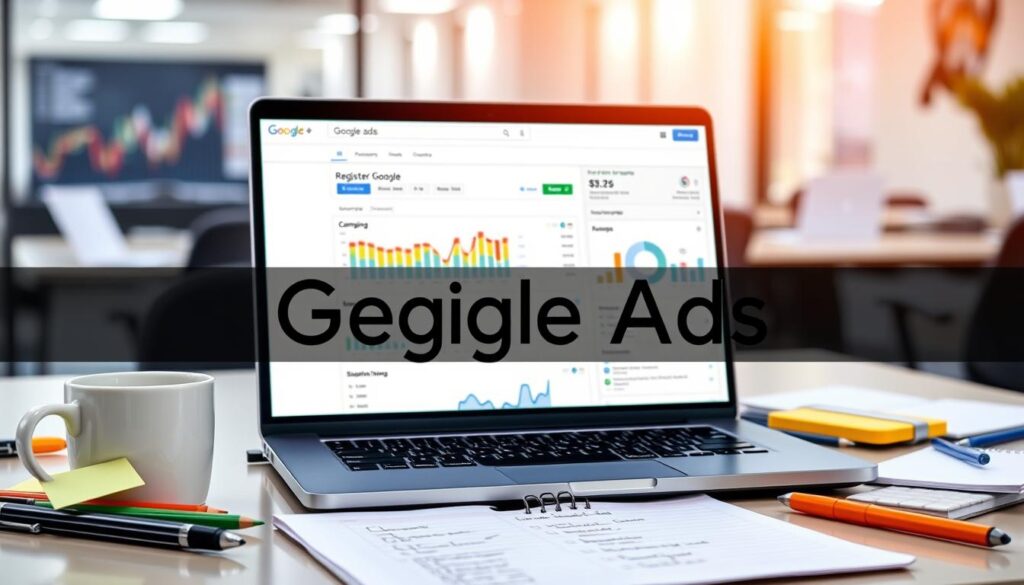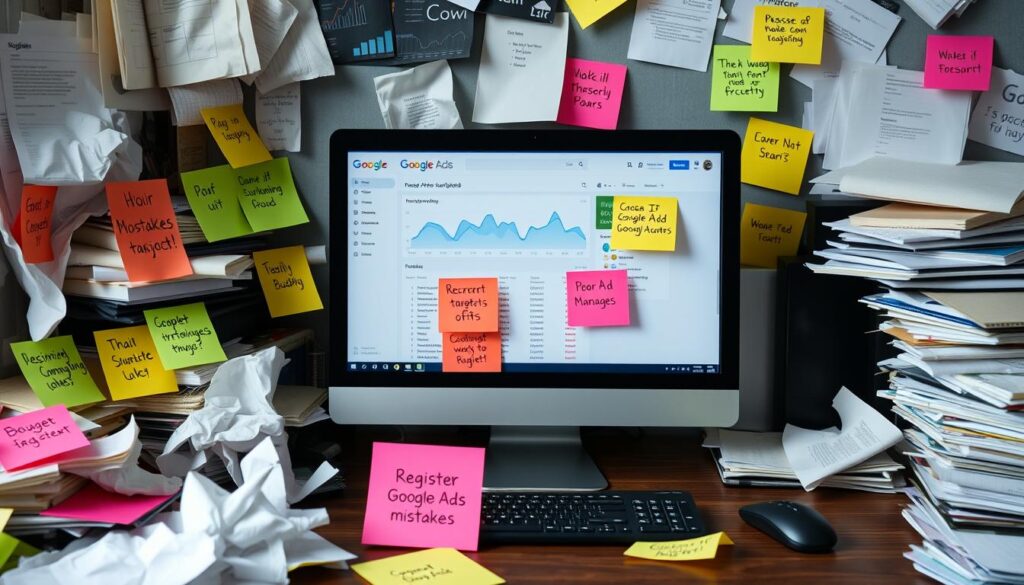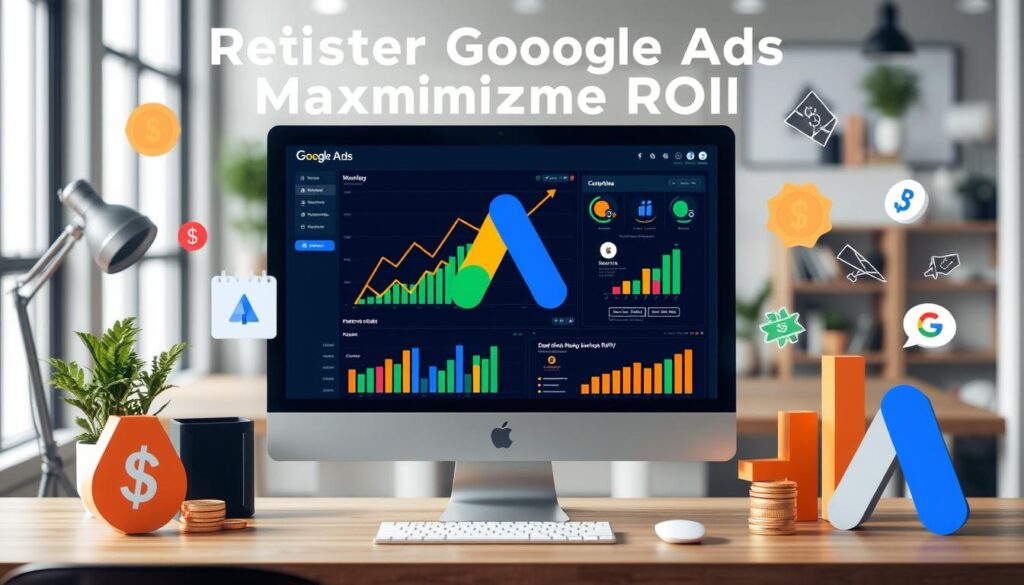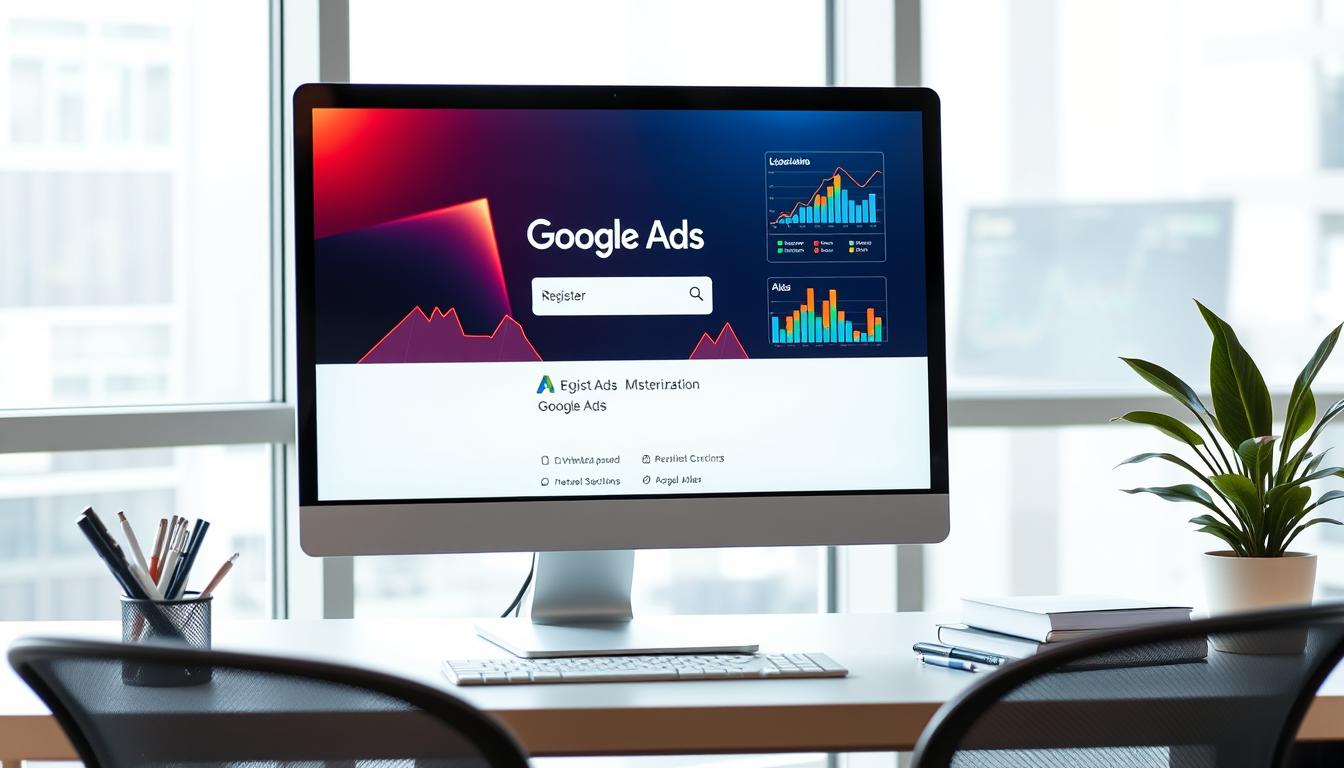Looking to grow your online presence and reach more people? Google Ads can help you do just that. It lets you create campaigns that bring more visitors to your site and boost sales. First, you need to sign up for Google Ads, but is it free? Yes, it’s free to start, and the sign-up process is easy.
Start by making a Google account if you don’t have one. Then, go to ads.google.com to sign up for Google Ads. You’ll find many campaign types to choose from, like Search, Display, and Video. You’ll also learn how to set your ad budget.
After signing up, you can pick from three special offers for new advertisers. These offers help you start your first campaign with a budget that fits you1. Google Ads also gives you ads credit when you meet certain spending requirements1. With Google Ads, you can learn how to use your budget wisely and get the most from your ads.
Key Takeaways
- Registering for Google Ads is easy and starts with a Google account.
- Knowing the different campaign types is key to using Google Ads well.
- Google Ads has special offers for new advertisers, including ads credit1.
- You can pick from various campaign types, like Search and Display, and learn about ad pricing.
- Google Ads offers tools and resources to help you use your budget effectively and sign up for ads.
- With Google Ads, you can make targeted campaigns to increase your website traffic and sales.
- Google Ads has a free account option, but you must pay for ads. You can learn more about trademark registration.
What Is Google Ads and Why Your Business Needs It
Google Ads is a powerful tool for businesses to show ads to their audience on Google platforms and millions of websites2. By creating a Google Ads account, businesses can boost their online presence, drive more website traffic, and get more leads3.
To start with Google Ads, businesses can sign up and create a campaign that fits their marketing goals3. The platform has many ad types, like search, display, and shopping ads. This lets businesses reach their audience in various ways2.
Understanding the Google Ads Platform
The Google Ads platform has many tools and features for managing ad campaigns2. By learning how to create a Google Ads account and set up a campaign, businesses can get the most out of their investment and meet their marketing goals3.
Benefits of Google Advertising
Google Ads brings many benefits to businesses, like more brand awareness, website traffic, and potential sales2. By using the platform’s targeting and ad formats, businesses can connect with their audience and increase sales3.
Types of Google Ads Campaigns
Google Ads has different campaign types, such as search, display, and shopping ads2. By creating a campaign and signing up for Google Ads, businesses can reach their audience and meet their marketing goals3.
| Campaign Type | Description |
|---|---|
| Search Ads | Text-based ads displayed on Google Search results pages |
| Display Ads | Visual ads displayed on websites, apps, and videos |
| Shopping Ads | Product-based ads displayed on Google Search results pages and other platforms |
How to Register for Google Ads: Step-by-Step Guide
To start with Google Ads, you first need to register. It’s easy and takes just a few steps. First, visit ads.google.com and click “get started”4. Then, add your business details, choose your goals and budget, and enter your payment info4.
Google Ads lets you pick your goals, like more calls or web sales5. You can also share your account with others, using their email or MCC IDs5.
When you sign up, you can link your YouTube and Google Business Profile for quicker setup4. You’ll also decide if you’re an “Organization” or “Individual” for tax reasons4. Plus, you’ll set your billing country, time zone, and payment method4.
After signing up, you can make your first ad campaign. Google Ads has tools like conversion tracking to help you improve your ads5. For more on registering, setting up, and signing up for Google Ads, check out their website4.
| Step | Description |
|---|---|
| 1 | Add business information |
| 2 | Select campaign goals and budget |
| 3 | Enter payment details |
By following these steps, you can easily register for Google Ads and start your first ad campaign. For more details on registering, setting up, and signing up for Google Ads, visit their website4.
Creating Your First Google Ads Account
To start with Google Ads, you first need a Google account6. You’ll need to give some basic business info and set up your billing. This makes sure your Google Ads account works well.
Setting up your Google Ads account means giving out your business details. You’ll need to verify your email and phone number6. Also, you must set up your billing info, like how you’ll pay and where you live.
Required Documentation
You’ll need to give your business name, address, and contact info to create a Google Ads account. You must also verify your email and phone number6.
Account Verification Process
The verification for Google Ads checks your email and phone number. This step is key to making sure your account works right and avoids any problems6.
Setting Up Billing Information
Setting up your billing is a big part of making a Google Ads account. You’ll need to give your payment info and where you live. Advertisers set daily budgets for their campaigns6.
By doing these steps, you can make a Google Ads account and start promoting your business online. To do this, you need to go through the account creation process. Then, you can log in to your account6.
Google Ads Cost Structure Explained
When businesses think about Google Ads, cost is a big worry. How much does google ads cost varies a lot. It depends on things like how you bid, how visible your ads are, and how well your campaign does7. On average, Google Ads can cost between $100 and $10,000 a month. Most businesses pay between $0.11 and $0.50 per click and $0.51 to $1000 per 1000 impressions in 20247.
Knowing how google ads pricing works is key to a good campaign. Some industries, like consumer services, pay almost $7 per click on average7. Here are some average CPCs for different industries:
Also, Google Ads can give you an 800% return on investment, or $8 for every $1 spent8. This shows the value of using Google Ads, even with the costs. By understanding the google ads cost structure and how it affects your business, you can make smart choices about your budget and strategy.
To succeed with Google Ads, you need to balance your budget and performance. Keep an eye on how your campaign is doing and tweak your strategy as needed. This way, you can get the most out of your investment and reach your business goals8.
Setting Your Google Ads Budget
Setting your Google Ads budget is key to reaching your business goals. To figure out your daily budget, use this formula: Daily budget = Monthly budget / 30.49. This way, you can use your budget wisely and get the best value from your Google Ads cost per click.
It’s also vital to think about the minimum budget you need. Businesses have seen success with budgets from $500 to $30,000 a month9. Knowing the average cost-per-click for your keywords is also crucial for setting your budget right9.
Daily vs. Monthly Budget Options
You can pick between daily and monthly budgets based on your business needs. The Google Ads industry spends around $9000 to $10,000 a month on PPC9. Think about your options and adjust your budget to get the most out of your Google Ads cost per click.
Minimum Budget Requirements
Remember, account budgets are needed for advertisers who pay monthly10. Your ads will stop if your budget is used up or if you set an end date10. Set a budget you can stick to and keep an eye on your ad performance. This way, you can adjust your Google Ads budget as needed.
Building Your First Ad Campaign
To make a successful Google Ads campaign, you need to know how to create one. First, pick a campaign type. Google Ads has many options like Search, Display, and Video11. Each type lets you target differently and choose ad formats that fit your needs11.
Next, set up ad groups, make ads, and choose who to target. Google Ads has tools like Google Keyword Planner for keywords. It also has ad extensions like Sitelink Extensions to make ads better12. You must also decide how much to spend and how much to bid, keeping an eye on metrics like CTR and Quality Score12.
Here are some key steps to follow when building your first ad campaign:
- Choose a campaign type based on your advertising goals
- Set up ad groups and create ads with compelling ad copy
- Define your targeting options, including location, language, and audience
- Set a budget and bid for ad placement
- Monitor and optimize your campaign performance using key performance metrics

By following these steps and using Google Ads tools, you can make a great campaign. Always check and improve your campaign to get the best results11. This way, you’ll meet your advertising goals and get a good return on investment12.
| Campaign Type | Description |
|---|---|
| Search Campaigns | Target users searching for specific keywords |
| Display Campaigns | Target users browsing websites, apps, and videos |
| Video Campaigns | Target users watching videos on YouTube and other platforms |
Google Ads Performance Tracking and Analytics
To manage and optimize your Google Ads campaigns well, tracking their performance is key. You need to watch metrics like conversions, click-through rate (CTR), and cost-per-conversion (CPC)13. This helps you spot where to improve and make smart choices for your ads.
Understanding your campaign reports is essential for google ads optimization. Look at bounce rate, average session duration, and pages per session14. These insights help you tweak your targeting, ad copy, and bids to increase your ROI. Plus, linking your Google Ads to Google Analytics 4 gives a deeper look at ad performance and user actions15.
Some important performance metrics to keep an eye on are:
- Conversion rate: The percentage of users who complete a desired action after clicking on your ad13.
- CTR: The ratio of users who click on your ad to the number of users who view it14.
- Cost-per-conversion: The average cost of each conversion, which helps you evaluate the effectiveness of your ad spend13.
By keeping an eye on these metrics and tweaking your strategies, you can boost your Google Ads campaigns’ performance. This leads to a better ROI13.
Common Google Ads Mistakes to Avoid
Managing Google Ads campaigns requires knowing common mistakes. Google ads mistakes can waste your ad spend and hurt your conversion rates. Research shows common errors include bad keyword research, not budgeting enough, and not optimizing campaigns16.
Some big google ads errors are not using negative keywords, not tracking conversions, and setting wrong bids16. Also, bad ad scheduling, not testing ads enough, and ignoring mobile optimization can harm your campaign16.
To avoid these mistakes, regularly check and improve your Google Ads campaigns. This means watching your keywords, adjusting bids, and using ad extensions well17. Knowing these common google ads mistakes and fixing them can make your campaigns better and save you money.

- Neglecting negative keywords
- Ignoring conversion tracking
- Setting inappropriate bids
- Poor ad scheduling
- Insufficient ad testing
By avoiding thesegoogle ads errors and actively managing your campaigns, you can make your Google Ads work better. This helps you reach your marketing goals16.
| Mistake | Impact |
|---|---|
| Poor keyword research | Wasted ad spend, poor conversion rates |
| Inadequate budgeting | Ineffective campaigns, poor ROI |
| Neglecting campaign optimization | Poor campaign performance, wasted ad spend |
By knowing these common mistakes and fixing them, you can make your Google Ads campaigns better. This will help you get a better return on your investment17.
Google Ads vs Other Advertising Platforms
Businesses have many choices for online ads, like Google Ads, Facebook Ads, and traditional ads. A google ads comparison with others helps pick the best. Google Ads is great for search ads, while Facebook Ads is good for targeting specific groups18.
In a google ads vs facebook ads look, Google Ads has better targeting. It includes demographic, geographic, and interest targeting18. Facebook Ads, with nearly three billion users, is huge19. Traditional ads, like print and TV, can work but don’t match online ads in targeting and tracking.
The table below shows the main differences between Google Ads, Facebook Ads, and traditional ads:
| Platform | Targeting Options | Measurability |
|---|---|---|
| Google Ads | Demographic, geographic, interest targeting | Highly measurable, with conversion tracking and ROI analysis |
| Facebook Ads | Demographic, interest, behavioral targeting | Measurable, with conversion tracking and ROI analysis |
| Traditional Advertising | Limited targeting options | Difficult to measure, with limited tracking and ROI analysis |
In a google ads vs traditional advertising look, Google Ads wins in targeting and tracking18. But, traditional ads can still work for some businesses. The right choice depends on what each business needs and wants.
Maximizing ROI with Google Ads
To boost your google ads roi, focus on making your campaigns better. This means looking at how they’re doing and tweaking them to get better results20. Find out which ads and groups are doing well and adjust your bids to get even better outcomes. This way, you can up your chances of getting a higher roi from google ads.
Setting clear goals for your google ads campaign is key. You might want to boost conversions or get more people to visit your site21. Having clear goals helps you see if your campaign is working. Also, making ads that really speak to your audience can get more people to engage and convert, which means more roi21.
Using demographic and location targeting in google ads is also crucial21. It lets you show your ads to the right people, based on things like age, gender, and where they live. Plus, testing different ads and focusing on quality score can help cut costs and improve where your ads show up, both of which can boost your roi20.
Here are some key strategies for maximizing roi with google ads:
- Set clear goals for your campaign
- Create high-quality ad content
- Utilize demographic and location targeting
- Use a/b testing to optimize ad content
- Focus on quality score to optimize ad costs and placements
By using these strategies and always keeping an eye on and tweaking your campaign, you can increase your google ads roi and get a better return on investment20.

Remember, getting the most out of google ads takes work and constant improvement. By keeping your goals in mind and always trying to make your campaign better, you can get more conversions and boost your roi21.
Best Practices for Google Ads Success
To succeed with Google Ads, focus on choosing the right keywords, optimizing ad copy, and matching landing pages to ads. By picking relevant keywords and making ad copy more appealing, businesses can do better22. It’s also key to make sure landing pages match the ad’s message for better results23.
Some top strategies include using broad match keywords to catch more searches23. Also, use geo-targeting to show ads in the right places24. Smart Bidding with broad match keywords can also help ads work better for conversions with Google AI22.
Here are some tips for optimizing Google Ads:
- Use keywords in at least 2 headlines and include at least 2 unique descriptions in responsive search ads22
- Provide at least 8-10 headlines for each responsive search ad for better ad performance22
- Include action-oriented language and create urgency with limited-time offers to improve ad performance23
By following these tips, businesses can make their Google Ads campaigns more effective and get a better return on investment. It’s important to keep an eye on how campaigns are doing and remove keywords that don’t work well23. Also, track conversions and test different landing page versions to see which one works best24.
| Google Ads Best Practices | Benefits |
|---|---|
| Keyword Selection | Improved ad relevance and targeting |
| Ad Copy Optimization | Increased CTR and conversion rates |
| Landing Page Alignment | Enhanced user experience and conversion rates |
Troubleshooting Google Ads Issues
When you face google ads troubleshooting, knowing common google ads issues and fixes is key25. shows that problems include ads not being seen, high costs per click, and low conversion rates. To fix these google ads problems, check your campaign settings, ad targeting, and how you bid.
Understanding what affects ad performance is crucial in google ads troubleshooting. For example, running out of budget can stop campaigns from showing or getting little traffic26. Also, ad quality is important because it impacts how users see Search ads26.
To solve google ads issues, take these steps:
- Look at impression share data to see why ads weren’t shown26
- Check if your ad targeting and bidding match your campaign goals
- Use ad extensions to boost click-through rates by up to 15%25
By following these steps and knowing common google ads problems, you can fix and improve your Google Ads campaigns. Always keep an eye on your campaigns and tweak them as needed for the best results26.
For more on google ads issues and how to fix them, check out Google Ads support resources25.
| Common Google Ads Issues | Solutions |
|---|---|
| Low ad visibility | Analyze campaign settings and ad targeting |
| High CPC | Review bidding strategies and ad quality |
| Poor conversion rates | Utilize features like ad extensions and optimize landing pages |
Conclusion: Making Google Ads Work for Your Business
Google Ads can be a game-changer for businesses of all sizes. It helps you reach your target audience and see real results. By understanding how it works, setting a smart budget, and always improving your ads, you can make the most of Google Ads.
Success with Google Ads comes from knowing it inside out, always tweaking your ads, tracking conversions, and managing them well27. With more than half the world online, online ads are more crucial than ever. Google’s vast network and precise targeting help you find and connect with your perfect customers.
Google Ads is great for both small local businesses and big companies looking to grow28. It offers tools to track how well your ads are doing. By keeping a close eye on your ads and making adjustments, you can get the most out of your investment.
So, it’s time to start using Google Ads for your business. With the right plan, hard work, and continuous improvement, you can harness the power of targeted ads. This will help your business grow in exciting ways.
